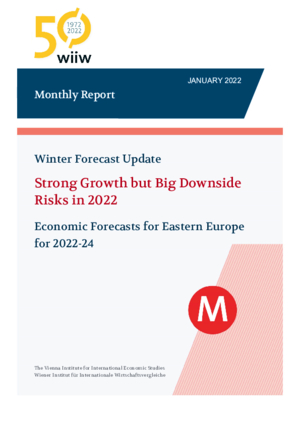Monthly Report No. 1/2022
Vasily Astrov, Alexandra Bykova, Rumen Dobrinsky, Selena Duraković, Richard Grieveson, Doris Hanzl-Weiss, Marcus How, Gabor Hunya, Branimir Jovanović, Niko Korpar, Sebastian Leitner, Isilda Mara, Olga Pindyuk, Sandor Richter, Bernd Christoph Ströhm, Maryna Tverdostup, Nina Vujanović, Zuzana Zavarská and Adam Żurawski
wiiw Monthly Report No. 1, January 2022
58 pages including 4 Tables and 21 Figures
OVERVIEW 2020-2021 AND OUTLOOK 2022-2024
Premium Members only
Summary of key recent macroeconomic data for CESEE, and overview of new wiiw forecasts for 2022-2024 (Excel file)
Winter Forecast Update
Strong Growth but Big Downside Risks in 2022
Economic Forecasts for Eastern Europe for 2022-24
In CESEE, both inflation and COVID-19 cases are rising rapidly. Plan A in the region seems to be to hope that both problems largely resolve themselves, with real interest rates set to remain mostly negative and COVID-19 restrictions limited. Our baseline macroeconomic outlook for the region is relatively upbeat, reflecting adaptability, resilience, and the assumption that the vast majority of COVID-19 cases in the current and any further waves of the pandemic will be very mild. Although CESEE growth will slow from 5.7% last year to 3.2% in 2022, this reflects the phasing-out of favourable base effects from 2020 and the weak performance of the region’s two biggest economies, Russia and Turkey. In both EU-CEE and the Western Balkans, real growth will top 4% this year – a slowdown from 2021, but still a healthy rate of expansion. However, there are material downside risks to these forecasts, especially owing to the possibility that high inflation will dampen economic growth momentum. Meanwhile, political risks are at their highest since 2014 in the former Soviet Union, and highest since the 1990s in the Western Balkans. A Russian invasion of Ukraine would lead to a renewed exchange of sanctions with the West and an even sharper spike in energy prices, damaging the economies of both sides.
Overview by Richard Grieveson
Most economies in CESEE will post robust growth again this year, but both Russia and Turkey are set for a slowdown, and downside risks have risen across the region.
Political risks in CESEE in 2022 by Marcus How
Political risks in CESEE are at their highest level since the 1990s, due to a combination of the threats of war in Ukraine and secession in Bosnia and Herzegovina, and some key elections in EU-CEE.
Country updates:
- Albania: Strong rebound in investment and consumption boosts growth by Isilda Mara
- Belarus: Economic prospects remain gloomy by Rumen Dobrinsky
- Bosnia and Herzegovina: Political tensions reach the highest level since the 1990s by Selena Duraković
- Bulgaria: New government, but major economic policy changes unlikely by Rumen Dobrinsky
- Croatia: Solid growth following stellar recovery by Bernd Christoph Ströhm
- Czechia: Resilient growth despite bumps in the road by Zuzana Zavarská
- Estonia: Growth approaching the limits by Maryna Tverdostup
- Hungary: Time to step on the brakes by Sándor Richter
- Kazakhstan: Stable outlook despite recent turmoil by Alexandra Bykova
- Kosovo: Growth momentum hampered by energy crisis by Isilda Mara
- Latvia: Further restrictions slow down recovery by Sebastian Leitner
- Lithuania: Economic catch-up continues amidst the pandemic by Sebastian Leitner
- Moldova: Hit by Russian gas price hikes by Gábor Hunya
- Montenegro: Ambitious economic reform increases both optimism and the fiscal risks by Nina Vujanović
- North Macedonia: Can the new government stimulate the economy? by Branimir Jovanović
- Poland: Personal income tax reform off to a bad start by Adam Żurawski
- Romania: Stable government helps meet conditions for EU assistance by Gábor Hunya
- Russia: Geopolitical escalation on the cards by Vasily Astrov
- Serbia: Public spending lifts the economy by Branimir Jovanović
- Slovakia: Semiconductor shortage still constrains future growth by Doris Hanzl-Weiss
- Slovenia: Stable economic outlook to shape key election year by Niko Korpar
- Turkey: Weaker growth after currency collapse by Richard Grieveson
- Ukraine: Threat of military invasion by Russia by Olga Pindyuk
Reference to wiiw databases: wiiw Annual Database, wiiw Monthly Database, wiiw FDI Database
Keywords: CESEE, economic forecast, Central and Eastern Europe, Southeast Europe, Western Balkans, EU, euro area, CIS, coronavirus, COVID-19, Omicron, China, zero-COVID, pandemic, restrictions, lockdowns, EU Recovery and Resilience Facility, NextGenerationEU, semiconductors, credit, investment, exports, FDI, labour markets, unemployment, inflation, exchange rates, monetary policy, fiscal policy, near-shoring, political risks
JEL classification: E20, E21, E22, E23, E24, E31, E32, E5, E62, F21, F31, H60, I18, J20, J30, O47, O52, O57, P24, P27, P33, P52
Countries covered: Albania, Belarus, Bosnia and Herzegovina, Bulgaria, CESEE, Croatia, Czechia, Estonia, EU-CEE, European Union, Hungary, Kazakhstan, Kosovo, Latvia, Lithuania, Moldova, Montenegro, New EU Member States, North Macedonia, Poland, Romania, Russia, SEE, Serbia, Slovakia, Slovenia, Turkey, Ukraine, CIS
Research Areas: Macroeconomic Analysis and Policy
